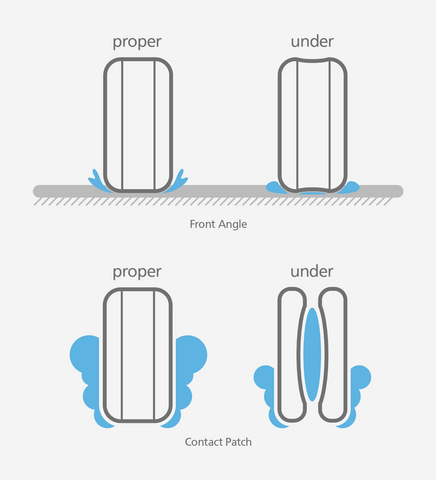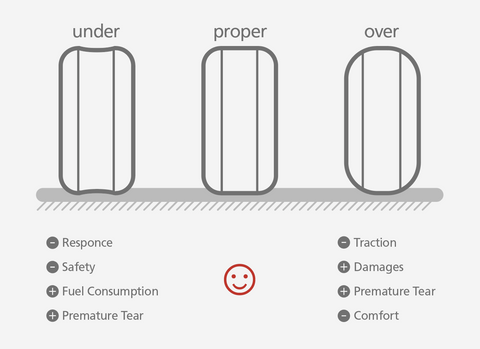How Much Pressure Should I Put in My Car Tires
When it comes to driving safety, tire pressure is always one of the hottest topics. Why does tire pressure matter? What the heck is that little annoying symbol on my dashboard? Should I under-inflate my tire during the winter? How often should I check my tire pressure?
We got tons of questions like this from our community, so for today, let's dive deep into the world of tire pressure, put our geeky glasses on and figure out everything you need to know about your tires.
1. What's The Recommended Tire Pressure For My Car?
The recommended tire pressure varies based on the vehicle makes determined by the manufacturer after thousands of tests and calculations. For most vehicles, you can find the ideal tire pressure on the sticker/card inside the driver's door for newer cars. If there's no sticker, you can usually find the info in the owner's manual. Normal tire pressure is usually between 32~40 psi(pounds per square inch) when they are cold. So make sure you check your tire pressure after a long stay and usually, you can do it in the early morning.

2. How To Check The Tire Pressure?
After knowing the proper tire pressure of your vehicle recommended by the manufacturer, you should check your tire pressure regularly to make sure that you are in good shape.
You can check your tire pressure in auto part stores, the mechanics, gas stations, and at home. To check tire pressure at home, you need:
- A Tire Pressure Gauge(Digital or Regular)
- Air Compressor
- Pen and paper / your phone
Step 1: Test with cold tires
As tire pressure changes with the temperature a lot, and recommended tire pressures are cold inflation pressure , you should start with cold tires if possible. We mostly check the tire pressure after one night's rest to avoid the heat from the friction of the last drive, and before the temperature goes up.
Step 2: Check the tire pressure with the gauge
Unscrew the valve cap and press the tire gauge onto the valve stem hard enough until the hissing sound disappears. There should be a reading as long as the gauge is well connected to the tire.
Step 3: Note down the readings
You can then note down the tire pressure of each tire, and compare them with the ideal psi you read from inside your driver's door or in the owner's manual. Make sure you read in detail, as for some vehicles, front and rear tires have different recommended psi.
Step 4: Fill your tires to the recommended psi
If you find a tire underinflated, use the air compressor to fill your tires. You can either buy an air compressor in the auto parts store or use one in a gas station. Remember to rest your tires for at least half an hour to make sure they're cold and the reading is accurate. If you have to fill your tires when the tires are hot, inflate them 3~4 psi above the recommended psi, and check again with your gauge when they are cold. It's ok to overinflate a bit when filling the tires, as you can let the air out with the gauge.
Step 5: Check the tire pressure again
After filling the tires, use your tire pressure gauge to check the tire pressure again and make sure they are in a good range. Let the air out a bit if they are over-inflated by pressing the gauge harder on the valve stem.
3. How To Maintain Proper Tire Inflation?
Tire maintenance is essential for the overall performance of your vehicle, and we highly recommend that you check your tire pressure every time you inflate your tire, each 10°F (5.6 °C) temperature change, and every 30 days.
Be mindful that don't wait until the TPMS(Tire Pressure Monitoring System) light come on before you check the tire pressure, as the normal TPMS may:
- Turn on after the tire pressure is well underinflated
- Cannot detect gradual air loss
- Cannot detect over-inflated tires
- Cannot tell which tire is under-inflated
- Cannot turn on if the TPMS is not transmitting the signal to the dashboard
- ...
For more information about the tire pressure monitoring system, please check our post about TPMS: What is TPMS and Why Does it Matter?
Thus, we highly recommend that you check your tire pressure regularly, especially before a long drive or heavy load driving. Also, temperature affects the tire pressure a lot, and we will explain it in the next section.
4. How Does Temperature Affect Tire Pressure?
First of all, the rule of thumb is for each 10°F (5.6 °C) decrease in temperature, the tire pressure will drop by one psi for most passenger vehicles. When it comes to commercial truck tires, which are often inflated to over 80 psi (twice as much as a passenger vehicle tires), the change of tire pressure according to temperature is doubled to 2 psi for every 10°F.
For the non-nerdy readers, just remember this rule of thumb and keep in mind that you will need to monitor your tire pressure during different seasons or a sudden temperature change. For those who want a deeper dive into how psi's are determined, here's the science behind it.
The equation we use to calculate the relationship between tire pressure and the temperature is called the Ideal Gas Law. It is a good approximation of the behavior of many gases under many conditions. ( Appx1) It works well for most low-pressure gases. When applied to tire pressure calculation, the error is less than 1%.
First, we take the Ideal Gas Law equation and apply it to our circumstance:
PV=nRT
where,
P = absolute pressure
V = gas volume in the tire
n = the number of molecules of gas in the tire
R = universal gas constant
T = temperature
Since we are trying to examine the pressure change according to the temperature, let's assume two tire pressures P1 & P2 at their set temperatures T1 & T2 .


Given the n and R are both constants, and the gas volume in the tire is also a constant, we can take those constants out of the equation, and suddenly we get this straightforward one:

Let's say the temperature drops from 100°F to 50°F, the tire pressure at 100°F is 35 psi, so what's the tire pressure now at 50°F?

(the metric system is getting in the way, huh?)
Absolute Pressure = tire pressure + sea level air pressure (14.7 psi). So,

Put all that into the equation,

So a 50°F drop in temperature lowers the air pressure by 4.5 psi, which is pretty much the same according to our rule of thumb.
5. How Does Tire Pressure Affect Driving
Both overinflation and underinflation affect your tire performance a lot, and serious problems might occur. According to NHTSA(National Highway Traffic Safety Administration), driving on underinflated tires increases a driver's chance of being in a serious accident by 300%. So how will a bad tire pressure affect driving safety? We will explain in detail below.
How tire pressure affects grip
The grip is mostly associated with the size of the contact patch between the tire and the road. An over-inflated tire radically decreases the contact patch while an under-inflated tire does the opposite.
A larger contact patch gives you more grip, and this is the exact reason why lots of racers will intentionally decrease their tire pressures to create a larger contact patch on a dry race track.
However, despite the fact that an under-inflated tire will cause more fuel consumption and improper tear and wear of the tires, for most daily commuters, it might cause an even scarier problem, which is hydroplaning.
Hydroplaning is a hazardous event when a layer of water builds between the wheels and the road surface, leading to a loss of traction that prevents the vehicle from responding to control inputs. (Appx2)
Hydroplaning occurs when the pressure of the tire pushing on the ground is equal to the water pushing back up on that tire. The size of the contact patch, given the force or the weight of the tire, is the same, directly affects the average pressure the tire's putting down on the road. The larger the contact patch (by deflating the tires), the less pressure it puts on that same area. So there's a causal relationship between your tire pressure and the possibility of a hydroplaning event.
Here's a more visual explanation of what is happening between a properly-inflated tire and an underinflated tire when driving on a wet road.

(waters could easily go under an under-inflated tire and cause hydroplaning)
To avoid a hydroplaning event, ALWAYS inflate your tires properly. Also, check your tires' treads, which make the water flow around the tires more efficiently, and of course, driving slow is always a big plus.
How tire pressure affects tire wear
The contact patch directly decides the pattern of the tire's wear and tear. You don't want your tires to wear out prematurely just because you have an over or under-inflated tire.

How tire pressure affects fuel economy
Imagine you are a ball rolling on the ice, there's no friction between the two surfaces, how much extra force do you need to apply to keep the ball moving? Zero (Thanks, Newton). The same applies to your fuel consumption when it comes to driving on the road. The rolling resistance between your tires and the road significantly affects fuel economy, and by now we should all know the logic behind this, lower tire pressure leads to a larger contact patch, which causes higher rolling resistance, and thus, poor fuel economy.

A Michelin study showed that your tire is accountable for at least 1/5 of your total fuel consumption and a 1-bar of pressure drop (14.5 psi) would increase your fuel consumption by 3-5%.
6. Special Conditions For Tire Pressure Manipulation
There are of course circumstances where you want to manipulate your tire pressure to meet specific requirements. Like the aforementioned track race, or if you are driving on sand, mud, etc. However, as a daily commuter, we strongly suggest you regularly check your tire pressure, preferably once a week and anytime you might take a long road trip, and always keep the tires properly inflated!

(overview of tire properties under different pressure points)
Conclusion
Tire pressure is always a hot topic regarding driving safety, and it's important to keep an eye on the tire pressure to maximize fuel efficiency and safety.
Before you go
We'd like tooffer you our most popular ZUS Smart Vehicle Health Monitor for FREE to better take care of your car and save $$$ on car expenses. Claim your free unit here.

Top Posts from nonda:
What is a Car Diagnostic Test & How to DIY?
What Does Check Engine Light Mean & How to Fix it?
Best OBD2 Scanner & Code Reader: Complete Buying Guide
OBD2 Codes: What You Need to Know
Appendix 1 - Ideal gas law - Wikipedia.
Appendix 2 - Aquaplaning - Wikipedia.
How Much Pressure Should I Put in My Car Tires
Source: https://www.nonda.co/blogs/news/6-things-you-need-to-know-about-tire-pressure
0 Response to "How Much Pressure Should I Put in My Car Tires"
Post a Comment